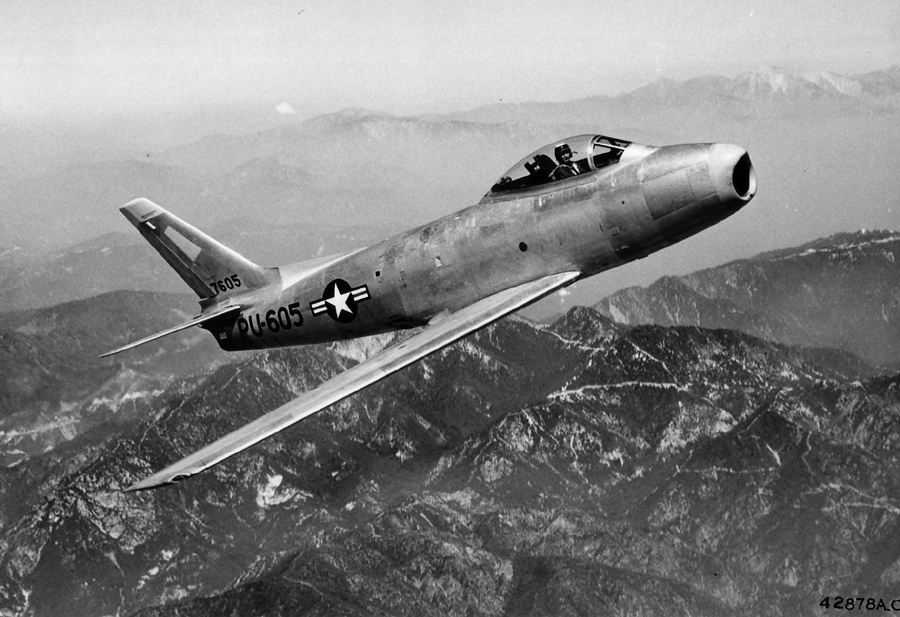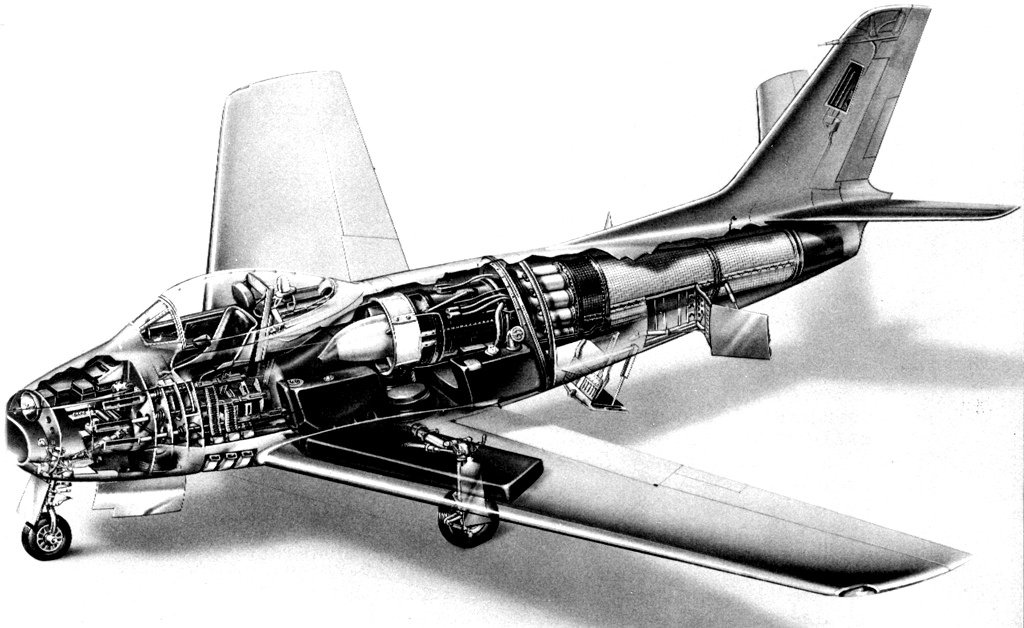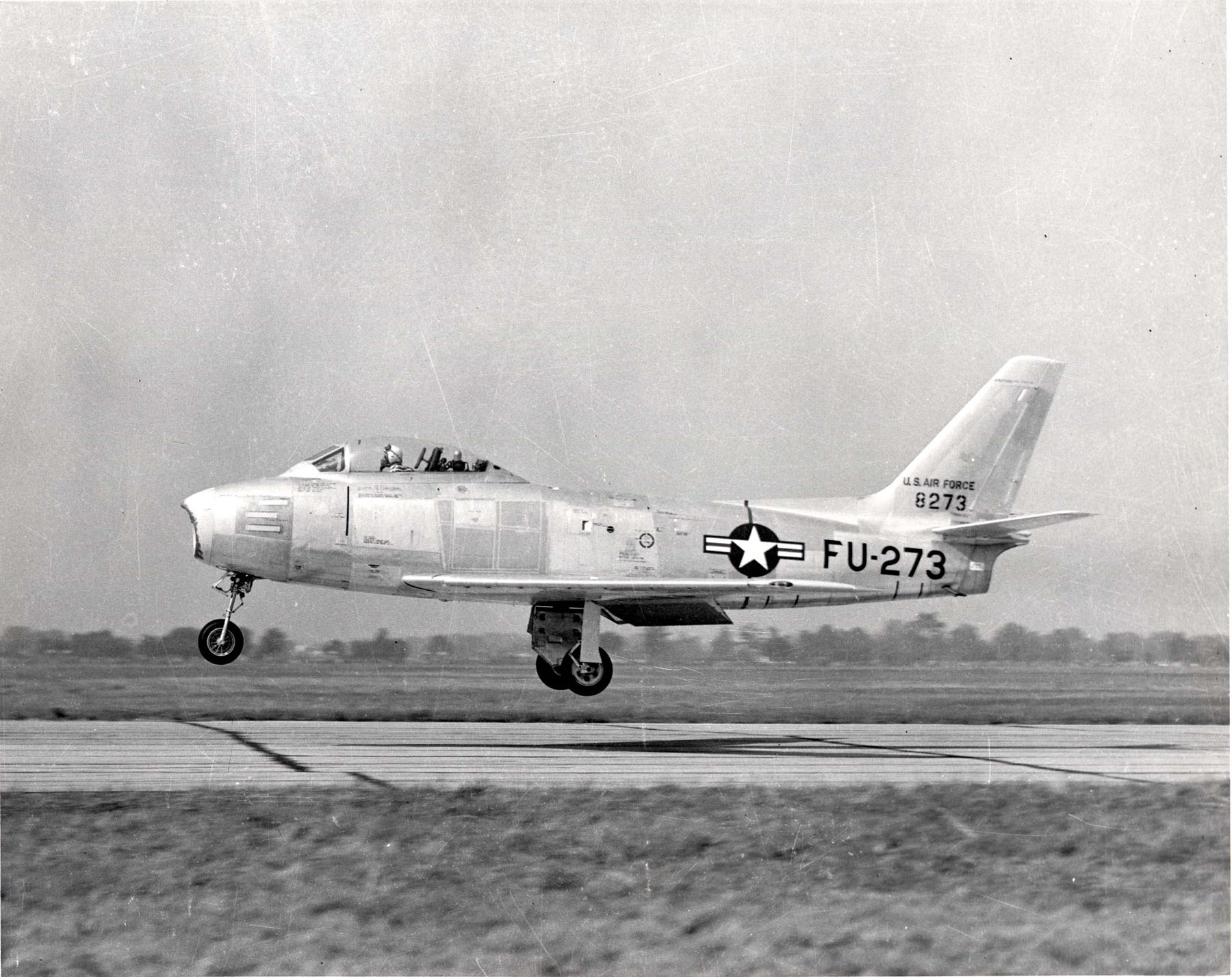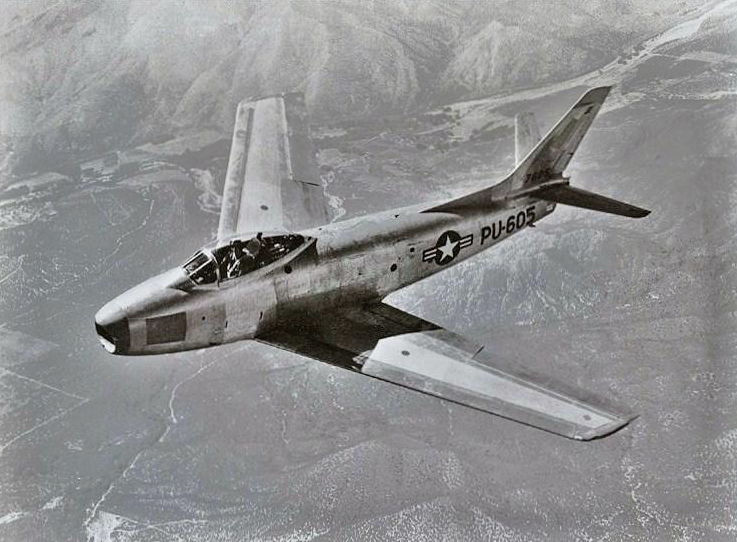
20 May 1948: The first production North American Aviation, Inc., P-86A-1-NA, 47-605, made its first flight.
The P-86A-1-NA was very similar to the three XP-86 prototypes. As an operational fighter, its empty weight increased 347 pounds to 10,077 pounds. The Chevrolet J35-C-3 and Allison J35-A-5 engines were replaced with a more powerful General Electric J47-GE-1. The fighter’s maximum speed increased 74 miles per hour to 673 miles per hour at Sea Level.
The P-86 was unlike any airplane before it. (The designation was changed to F-86 the following month.) It was the first airplane produced with a swept wing. After analyzing World War II test data for the Messerschmitt Me 262, North American’s engineers designed a wing with a 35° degree sweepback to its leading edge. The wing sweep allowed high speed shock waves to form without stalling the entire wing. The wing tapered toward the tips, and its thickness also decreased from the root to the tip. In order to create a very strong but very thin wing, it was built with a two-layered aluminum skin, instead of ribs and spars, with each layer separated by “hat” sections. The thickness of the skin panels also tapered to decrease weight.

The wing incorporated leading edge “slats” which were airfoil sections that automatically extended below 290 knots, smoothing the air flow over the wing’s upper surface and creating more lift at slow speeds. Above that speed, aerodynamic forces closed the slats, decreasing drag and allowing for higher speeds. Effectively, the wing could change its shape in flight.
Like the XP-86, the P-86A was 37 feet, 6.5 inches (11.443 meters) long with a wingspan of 37 feet, 1.4 inches (11.313 meters) and overall height of 14 feet, 8.9 inches (4.493 meters). The empty weight was 10,077 pounds (4,571 kilograms), gross weight, 14,050 pounds (6,373 kilograms) and maximum takeoff weight was 15,876 pounds (7,201 kilograms).
The J47-GE-1 was an axial-flow turbojet with a 12-stage compressor, 8 combustion chambers, and single stage turbine. It had a normal power rating of 4,320 pounds of thrust (19.216 kilonewtons) at 7,370 r.p.m.; and military power, 5,200 pounds (23.131 kilonewtons) at 7,950 r.p.m. (30-minute limit).
The P-86A had an initial rate of climb 7,470 feet per minute (37.95 meters per second) and could reach 40,000 feet (12,192 meters) in 10 minutes, 24 seconds. Its service ceiling was 48,000 feet (14,630 meters).

The Sabre was armed with six Browning AN-M3 .50-caliber aircraft machine guns placed in the nose, with three on either side of the engine intake. These were lighter and had a higher rate of fire than the World War II AN-M2 machine guns. Ammunition containers had a capacity of 300 rounds, but normally they carried 267 rounds per gun. Early aircraft had small doors covering each gun port. They opened in 0.05 seconds but were difficult to keep properly adjusted, so they were soon deleted.
The airplane could also be armed with two bombs and up to sixteen 5-inch (12.7 centimeter) High Velocity Aerial Rockets (HVAR) on underwing hardpoints.
North American Aviation built thirty-three P-86A-1-NAs. The U.S. Air Force ordered 190 F-86Bs, but these were cancelled in favor of the F-86A-5-NA.
The F-86A became operational with the 1st Fighter Group at March Air Force Base, near Riverside, California. In February 1949, a contest was held within the group to select a name for the new fighter. “Sabre” was chosen.

© 2019, Bryan R. Swopes
My all time favorite fighter. 22 years Active Duty in the Air Force, all on the flight line but never worked an ’86 ’till I retired!! Then, 11 years on ’86 E’s.
when form was as important as function.
1st to exceed the speed of sound. Two weeks before the Bell X-1.
the swedish J29 flew sept 1st 1948
The development was the P-51 was modified to a jet engine and became the Navy’s FJ 1 Fury; the wings were modified to swept wings and it beame the F-86
Hard to see much resemblance between the P-51 and the FJ-1, other than the wings and tail fins: https://www.thisdayinaviation.com/11-september-1946/
…first MiG-15 flight 12-30-1947 with English turbojet.
The prototype I-310 first flew on that date, while the first production MiG-15 first flew 31 December 1948. Please see TDiA at: https://www.thisdayinaviation.com/30-december-1947/ and https://www.thisdayinaviation.com/31-december-1948/